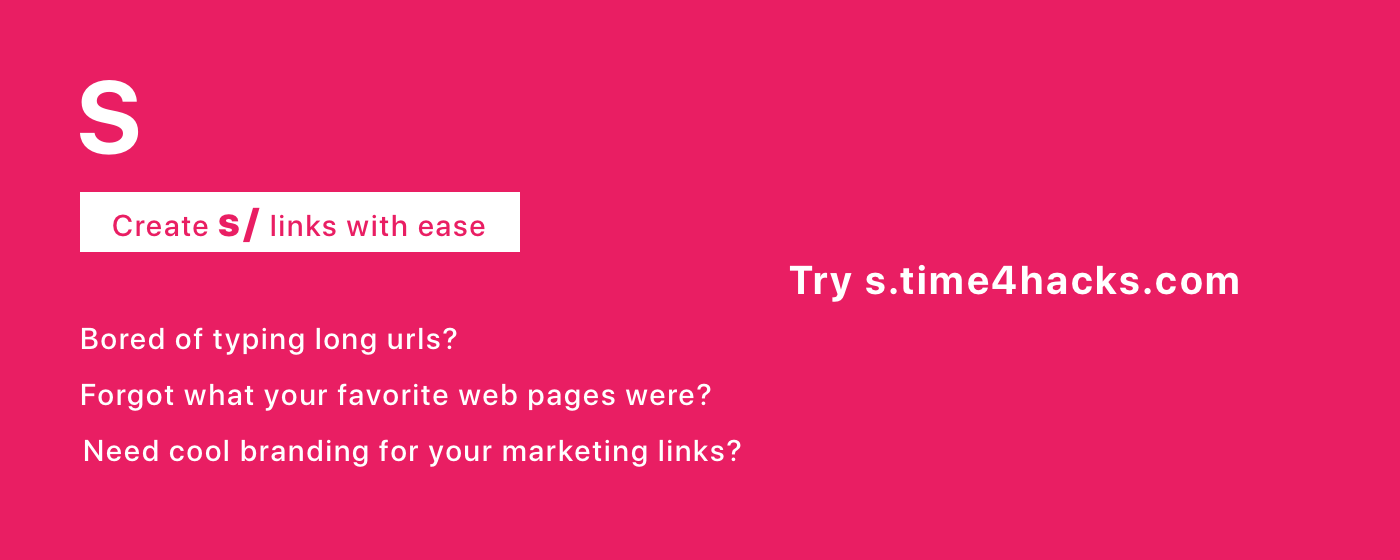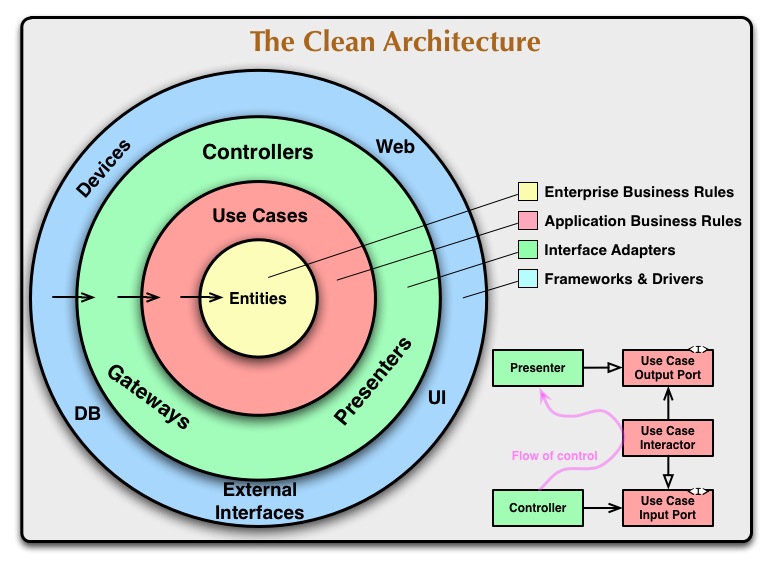Short
Preview
Get s/ Chrome extension
Install it from Chrome Web Store or build it from source
Getting Started
Accessing the source code
git clone https://github.com/byliuyang/short.gitPrerequisites
- Docker v19.03.2
Configure environmental variables
-
Create
.envfile at project root with the following content:DOCKERHUB_USERNAME=local DB_USER=your_db_user DB_PASSWORD=your_db_password DB_NAME=your_db_name RECAPTCHA_SECRET=your_recaptcha_secret GITHUB_CLIENT_ID=your_Github_client_id GITHUB_CLIENT_SECRET= your_Github_client_secret JWT_SECRET= your_JWT_secret WEB_FRONTEND_URL=http://localhost:3000 WEB_PORT=3000 HTTP_API_PORT=80 GRAPHQL_API_PORT=8080
-
Update
DB_USER,DB_PASSWORD,DB_NAME, andJWT_SECRETwith your own configurations.
Create reCAPTCHA account
-
Sign up at ReCAPTCHA with the following configurations:
Field Value Label ShortreCAPTCHA type reCAPTCHAv3Domains localhost -
Replace the value of
RECAPTCHA_SECRETin the.envfile withSECRET KEY. -
Replace the value of
REACT_APP_RECAPTCHA_SITE_KEYinfrontend/.env.developmentfile withSITE_KEY.
Create Github OAuth application
-
Create a new OAuth app at Github Developers with the following configurations:
Field Value Application Name ShortHomepage URL http://localhostApplication description URL shortening service written in Go and ReactAuthorization callback URL http://localhost/oauth/github/sign-in/callback -
Replace the value of
GITHUB_CLIENT_IDin the.envfile withClient ID. -
Replace the value of
GITHUB_CLIENT_SECRETin the.envfile withClient Secret.
Generate static assets
Run the following commands at project root:
docker build -t frontend-build -f Dockerfile-build .
docker run -v $(pwd)/frontend/build:/app/build frontend-build:latestBuild frontend & backend docker images
docker build -t short-frontend:latest -f frontend/Dockerfile frontend
docker build -t short-backend:latest -f backend/Dockerfile backendLaunch App
docker-compose upVisit http://localhost:3000
Development
Dependencies
- Go v1.13.1
- Node.js v12.12.0
- Yarn v1.19.1
- Postgresql v12.0 ( or use ElephantSQL instead )
Backend
-
Create
.envunderbackenddirectory with the following content:DB_HOST=your_db_host DB_PORT=your_db_port DB_USER=your_db_user DB_PASSWORD=your_db_password DB_NAME=your_db_name RECAPTCHA_SECRET=your_recaptcha_secret GITHUB_CLIENT_ID=your_Github_client_id GITHUB_CLIENT_SECRET=your_Github_client_secret JWT_SECRET=your_JWT_secret WEB_FRONTEND_URL=http://localhost:3000
-
Update
DB_HOST,DB_PORT,DB_USER,DB_PASSWORD,DB_NAME,RECAPTCHA_SECRET,GITHUB_CLIENT_ID,GITHUB_CLIENT_SECRET,JWT_SECRETwith your own configurations. -
Launch backend server
cd backend ./scripts/dev -
Remember to install developers tools before start coding:
./scripts/tools
Frontend
Remember to update REACT_APP_RECAPTCHA_SITE_KEY in frontend/.env.development.
-
Launch frontend server
cd frontend ./scripts/dev -
Visit http://localhost:3000
System Design
App Level Architecture
Short backend is built on top of Uncle Bob's Clean Architecture, the central objective of which is separation of concerns.
It enables the developers to modify a single component of the system at a time while leaving the rest unchanged. This minizes the amount of changes have to be made in order to support new requirements as the system grows. Clean Architecture also improves the testability of system, which in turn saves precious time when creating automated tests.
Service Level Archtecture
Short adopts Microservices Architecture to organize dependent services around business capabilities and to enable independent deployment of each service.
Dependency Management
Short leverages class design, package cohesion, and package coupling princiapls from C++ world to manage its internal dependencies.
Class Design
| Principal | Description |
|---|---|
| Single Responsibility Principle | A class should have one, and only one, reason to change. |
| Open Closed Principle | You should be able to extend a classes behavior, without modifying it. |
| Liskov Substitution Principle | Derived classes must be substitutable for their base classes. |
| Interface Segregation Principle | Make fine grained interfaces that are client specific. |
| Dependency Inversion Principle | Depend on abstractions, not on concretions. |
Package Cohesion
| Principal | Description |
|---|---|
| Release Reuse Equivalency Principle | The granule of reuse is the granule of release. |
| The Common Closure Principle | Classes that change together are packaged together. |
| The Common Reuse Principle | Classes that are used together are packaged together. |
Package Coupling
| Principal | Description |
|---|---|
| Acyclic Dependencies Principle | The dependency graph of packages must have no cycles. |
| Stable Dependencies Principle | Depend in the direction of stability. |
| Stable Abstractions Principle | Abstractness increases with stability. |
Dependency Injection
Short produces flexible and loosely coupled code, by explicitly providing components with all of the dependencies they need.
type Authenticator struct {
tokenizer fw.CryptoTokenizer
timer fw.Timer
tokenValidDuration time.Duration
}
func NewAuthenticator(
tokenizer fw.CryptoTokenizer,
timer fw.Timer,
tokenValidDuration time.Duration,
) Authenticator {
return Authenticator{
tokenizer: tokenizer,
timer: timer,
tokenValidDuration: tokenValidDuration,
}
}Short also simplifies the management of the big block of order-dependent initialization code with Wire, a compile time depedency injection framework by Google.
func InjectGraphQlService(
name string,
sqlDB *sql.DB,
graphqlPath provider.GraphQlPath,
secret provider.ReCaptchaSecret,
jwtSecret provider.JwtSecret,
bufferSize provider.KeyGenBufferSize,
kgsRPCConfig provider.KgsRPCConfig,
) (mdservice.Service, error) {
wire.Build(
wire.Bind(new(fw.GraphQlAPI), new(graphql.Short)),
wire.Bind(new(url.Retriever), new(url.RetrieverPersist)),
wire.Bind(new(url.Creator), new(url.CreatorPersist)),
wire.Bind(new(repo.UserURLRelation), new(db.UserURLRelationSQL)),
wire.Bind(new(repo.URL), new(*db.URLSql)),
wire.Bind(new(keygen.KeyGenerator), new(keygen.Remote)),
wire.Bind(new(service.KeyFetcher), new(kgs.RPC)),
observabilitySet,
authSet,
mdservice.New,
provider.NewGraphGophers,
mdhttp.NewClient,
mdrequest.NewHTTP,
mdtimer.NewTimer,
db.NewURLSql,
db.NewUserURLRelationSQL,
provider.NewRemote,
url.NewRetrieverPersist,
url.NewCreatorPersist,
provider.NewKgsRPC,
provider.NewReCaptchaService,
requester.NewVerifier,
graphql.NewShort,
)
return mdservice.Service{}, nil
}Database Modeling
Deployment
Merging from master branch to production branch on Github will automatically
deploy the latest code to the production server. This is called continuous
delivery in the DevOps world.
In the future, when there are enough automated tests, we may migrate to continuous deployment instead.
Tools We Use
- Drone: Continuous integration written in Go
- Code Climate: Automated code review
- ElephantSQL: Managed PostgreSQL service.
Contributing
When contributing to this repository, please first discuss the change you wish to make via Slack channel with the owner of this repository before making a change.
Please open a draft pull request when you are working on an issue so that the owner knows it is in progress. The owner may take over or reassign the issue if no body replies after ten days assigned to you.
Pull Request Process
- Update the README.md with details of changes to the interface, this includes new environment variables, exposed ports, useful file locations and container parameters.
- You may merge the Pull Request in once you have the sign-off of code owner, or if you do not have permission to do that, you may request the code owner to merge it for you.
Code of Conduct
- Using welcoming and inclusive language
- Being respectful of differing viewpoints and experiences
- Gracefully accepting constructive criticism
- Focusing on what is best for the community
- Showing empathy towards other community members
Discussions
Please join this Slack channel to discuss bugs, dev environment setup, tooling, and coding best practices.
Author
Harry Liu - Initial work - byliuyang
License
This project is maintained under MIT license






